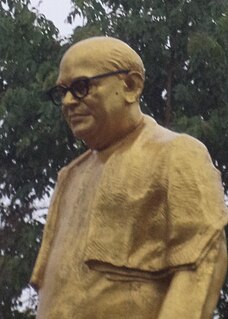
India is a federal union comprising 29 states and 7 union territories, for a total of 36 entities. The states and union territories are further subdivided into districts and smaller administrative divisions.

Mysore State was a separate state within the Union of India from 1948 until 1956 with Mysore as its capital. The state was considerably enlarged in 1956 when it became a linguistically homogeneous Kannada-speaking state in 1956, within the Union of India. It was subsequently incorporated into the state of Karnataka.
The States Reorganisation Commission (SRC) was a body constituted by the Central Government of India in 1953 to recommend the reorganisation of state boundaries. In 1955, after nearly 2 years of study, the Commission recommended that India's state boundaries should be reorganised to form 16 states and 3 union territories; But Finally the union of India made with slightly changes in the Commission's recommendation and made 14 States And 6 territorial states Name of 14 states viz Andhra, Assam, Bhihar, Bombay(Maharashtra+Gujarat), Jammu &Kashmir,Kerala,Madras, Mysore, Orissa, Panjab(PEPSU- Panjab+Haryana), Rajstan, Uttar pradesh,West Bengal etc And 6 territory viz Andaman and Nikobar, Lakadiv, Minikoy and Amindevi(Lakshdweep), Delhi, Himachal pradesh, Tripura and Manipur etc.

The second legislative assembly election to the Madras state was held on 31 March 1957. This was the first election held after the linguistic reorganisation of Madras state in 1954. Indian National Congress and its leader K. Kamaraj won the election, and defeated its rival Dravida Munnetra Kazhagam. In 1954, due to the resignation of C. Rajagopalachari, for his controversial Kula Kalvi Thittam, the leadership of Congress was contested, between K. Kamaraj, and C. Subramaniam. Eventually, K. Kamaraj, won the support of the party, was elected leader and chief minister of Madras State in 1954. In a surprise move, he appointed both M. Bhaktavatsalam and C. Subramaniam, in his cabinet, allowing great unity amongst Congress, that ruled the state of Madras, for the next decade. This election saw future DMK leaders, M. Karunanidhi and K. Anbazhagan winning their first MLA seat in the legislative assembly.

Elections to the Legislative Assembly of the Indian state of Hyderabad were held on 27 March 1952. 564 candidates competed for the 175 seats in the Assembly. There were 33 two-member constituencies and 109 constituencies single-member constituencies.

Elections to the Legislative Assembly of the Indian state of Bombay were held on 26 March 1952. 1239 candidates contested for the 260 constituencies in the Assembly. There were 1 three-member, 47 two-member constituencies and 212 single-member constituencies.

Elections to the Madhya Pradesh Legislative Assembly were held on 26 March 1952. 1,122 candidates contested for the 184 constituencies in the Assembly. There were 48 two-member constituencies and 136 single-member constituencies. On 1 November 1956, under States Reorganisation Act, 1956, Madhya Bharat, Vindhya Pradesh, and Bhopal state were merged into Madhya Pradesh and the Marathi-speaking districts of Nagpur Division were transferred to Bombay State. Hence the constituencies were re-organized during 1957 elections.

Elections to the Legislative Assembly of the Indian state of Mysore were held on 26 March 1952. 394 candidates contested for the 80 constituencies in the Assembly. There were 19 two-member constituencies and 61 single-member constituencies.

Elections to the Rajasthan Legislative Assembly were held on February 29, 1952. 616 candidates contested for the 140 constituencies in the Assembly. There were 20 two-member constituencies and 120 single-member constituencies.
Elections to the Andhra State Legislative Assembly were held on February 11, 1955. 581 candidates contested for the 167 constituencies in the Assembly. There were 29 two-member constituencies and 138 single-member constituencies.
Elections to the Bombay Legislative Assembly were held on 25 February 1957. 1146 candidates contested for the 339 constituencies in the Assembly. There were 57 two-member constituencies and 282 single-member constituencies.
Elections to the Madhya Pradesh Legislative Assembly were held on 25 February 1957. 1,108 candidates contested for the 218 constituencies in the Assembly. There were 69 two-member constituencies and 149 single-member constituencies.

Elections to the Mysore Legislative Assembly were held on 25 February 1957. 589 candidates contested for the 208 seats of the 179 constituencies in the Assembly.
Kustagi Lok Sabha constituency was a former Lok Sabha constituency in Hyderabad State. This seat came into existence in 1951. With the implementation of States Reorganisation Act, 1956, it ceased to exist.
Yadgir Lok Sabha constituency was a former Lok Sabha constituency in Hyderabad State. This seat came into existence in 1951. With the implementation of States Reorganisation Act, 1956, it ceased to exist.








